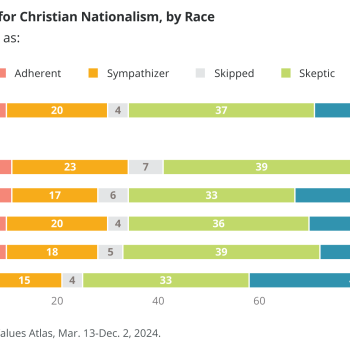While a national denomination fitfully advanced an agenda of social justice and civil rights, my local congregation fractured. The session moderator, a host of leading congregants, and much of the attendance disappeared. Week by week, the numbers dwindled. Empty pews were disillusioning. Across the country, congregations were leaving and joining a splinter denomination, and bitter property fights raged. The tumult accelerated the main denomination’s numerical decline.
The results made me ask: why had the denomination taken a step when it was obvious the above would ensue? Was it worth the congregational divorces? The impairment of the church’s ability to carry out its missions of evangelism and social justice?
The above is an account of what happened to my Presbyterian congregation in southern Alabama two years ago after the Presbyterian Church (U.S.A.) reversed policy and removed restrictions on the ordination of same-sex ministerial candidates. While less dramatic (no death threats and no standoffs at the church doors), it somewhat parallels the narrative in Carolyn Dupont’s Mississippi Praying. While rather wide-ranging in its narrative, Dupont’s chief focus is on the internal developments within white evangelical churches during the civil rights era. With few exceptions, hers is not an encouraging story. It’s also a cautionary tale for Christians today. Dupont’s book is written in crisp and engaging prose. It deserves a wide audience outside academia. Indeed, it is a must read for anyone interested in the intersection of Christianity and race in America.
The book is full of gripping narrative. William Bryan Selah pastored Galloway Memorial Methodist Church, the largest Methodist congregation in Jackson, Mississippi. For a long while, Selah was a moderate segregation who opposed the idea that his denomination would force the integration of local churches. He spoke out against the Brown decision. However, as Dupont explains, “Selah’s devotion to the Methodist Church and his supple theological outlook reshaped his position over time.” In 1961, Selah insisted that his church open its doors to black worshipers, including the Freedom Riders, not because he liked the latter group but because he did not feel his church could bar any Christians from worship. When a substantial group of Mississippi Methodist pastors signed a fairly progressive statement on civil rights, congregants across the state stiffened their segregationist resolve. At Galloway Methodist, ushers turned away black worshipers. Selah was ready for this moment. He walked to the pulpit, scrapped his prepared sermon, and announced his resignation.
Unfortunately, there are too few William Selahs in this book. Dupont’s argument is that most Mississippi evangelicals vigorously (if sometimes subtly and quietly) supported segregation. Those few pastors who broke with the segregationist consensus usually found themselves out of work. There were enough moderates and progressives to muddy the waters (and frighten the conservatives), and Mississippi churches’ ties to nationally more progressive denominations greatly complicated the situation. Complicated it enough in my view to at least partly affirm David Chappell’s argument that a lack of white religious fervor and unanimity in favor of segregation helped the civil rights movement succeed. Still, Dupont convincingly shows that the vast majority of Mississippi evangelicals staunchly backed segregation through the mid-1960s. Closed doors, rescinded speaking invitations (when colleges had unwittingly invited white moderates), pro-segregationist literature — these characterized white Protestant churches in Mississippi.
Dupont also traces with great care the internal travails of Mississippi Southern Baptists, Southern Presbyterians, and Methodists. She argues that the theological response of Mississippi Baptists to the progressive stances on civil rights taken by the national SBC moved the entire denomination in a more conservative direction. She observes that Mississippi Methodists (who, unlike the Baptists and Presbyterians, had a significant number of black coreligionists) hemorrhaged members during the 1960s and 1970s, as denominational policies alienated local evangelicals. Mississippi Presbyterians largely withdrew from the Presbyterian Church in the United States to align themselves with the newly created Presbyterian Church in America.
By their actions, according to Dupont, white Mississippi evangelicals preserved the theology with which they had opposed the civil rights movement: biblical literalism and an intense focus on individual salvation to the (at least in theory) exclusion of social concerns. Dupont makes a strong case that opposition to civil rights was an important backdrop to the theological concerns that animated the conservative trend within the SBC and the creation of the PCA.
Indeed, her book is more than a chronicle of Deep South white evangelicals in the civil rights era. It is also an indictment of the individualistic theology of white evangelicalism. Readers should ponder this indictment. In Mississippi Praying, those Protestants with more complicated views of scripture and an openness to the social implications of the gospel are the moderates and progressives. At least some of them took (for Mississippi) bold stances on civil rights. Those with literalist views of scripture and an overwhelming focus on individual salvation backed segregation to the hilt. Furthermore, that conservative evangelical theology lived on in more monolithic denominations after the 1960s. Dupont finds the perpetuation of conservative, individualistic theology troubling:
For the most part, in this way of thinking, systems emerge only as the product of individual actions. Sin resides in people, not in the configuration of the society around them. The notion that the world might work in exactly the opposite way—that social, political, and economic arrangements might exert profound evil on individuals, limiting their destinies and proscribing their choices—hardly enters in. Vision so trained can hardly register the wickedness that ensues from social systems that hurt, disfigure, and profoundly disadvantage some, while reserving for others the best preparation, the choicest opportunities, and the smoothest pathways.
Does an overwhelming focus on personal salvation make it less likely that Christians will “register the wickedness that ensues from social systems that hurt, disfigure, and profoundly disadvantage some?” Yes, I think so. At the same time, while I agree with Dupont that one cannot simply blame a “culture” while absolving a “theology” (as if the two are not tightly connected), I hesitate to label “evangelical theology” the problem. One could take a rather literalist approach to scripture and arrive at very different conclusions about race and social justice. And the strict individualism of evangelicalism, Dupont herself shows, was largely a facade, as Mississippi evangelicals always focused on their communities as communities and not just as a collection of individuals. Still, hers is a powerful critique.
Finally, for the most part Dupont draws these larger conclusions without being uncharitable to the individuals involved in her story. She does have some sharp words for religious leaders who simply ducked the most pressing question of their era, blithely acting as if the civil rights protests were taking place on another planet. While certain moral judgments are inescapable, historians primarily write to explain rather than to assess their subjects. I found myself getting angry at the evangelicals in her story. How could they so profane the name of Jesus?
I tried to check myself by thinking about my congregation in Alabama. Regardless of how one comes down on a social issue, few within a congregation want their church to fracture. It’s painful, and most of the time, we try to avoid pain, even when it results from a remedy we sorely need.












